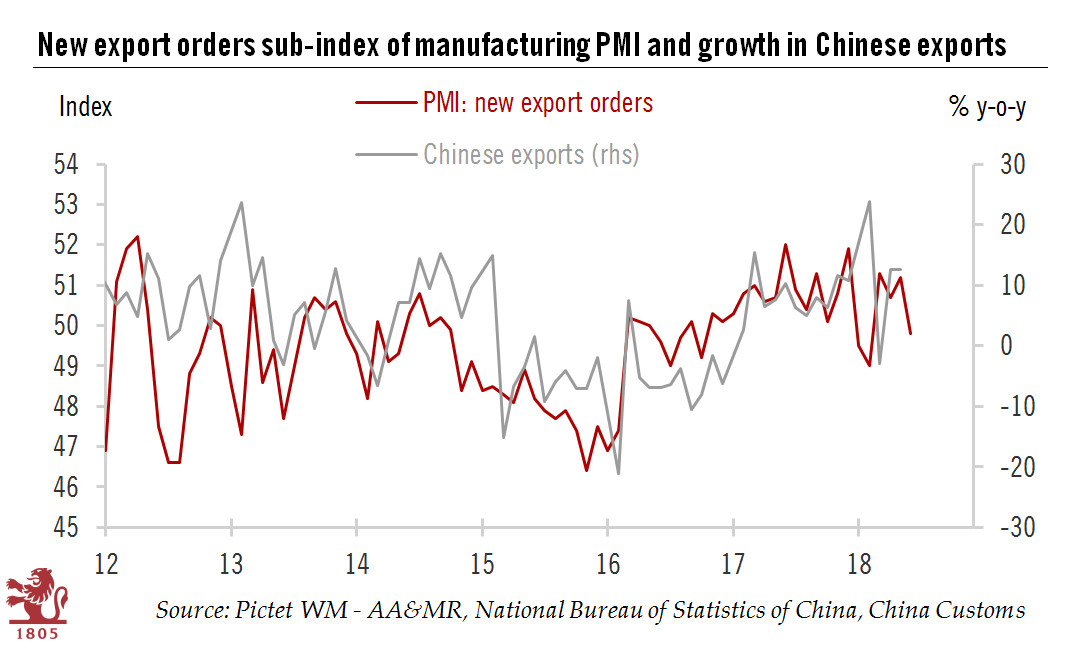In response to the weakening of growth momentum and the threat of a trade war with the US, the Chinese authorities are likely to continue to make monetary and fiscal adjustments.Recent data releases generally point to a softening in China’s growth momentum. The deceleration is most notable in fixed-asset investment and retail sales, and the rising trade tensions between US and China may have weighed on the export sector.The official manufacturing PMI for June came in at 51.5, down from 51.9 the previous month. The production, new orders and imports sub-indices, which are gauges for domestic demand, have all come off after a strong rebound earlier this year. External demand seems to have decelerated even more. The new export orders sub-index of the June PMI declined sharply to 49.8, from
Topics:
Dong Chen considers the following as important: China trade war, Chinese exports, Chinese growth, Chinese stimulus, Macroview
This could be interesting, too:
Cesar Perez Ruiz writes Weekly View – Big Splits
Cesar Perez Ruiz writes Weekly View – Central Bank Halloween
Cesar Perez Ruiz writes Weekly View – Widening bottlenecks
Cesar Perez Ruiz writes Weekly View – Debt ceiling deadline postponed
In response to the weakening of growth momentum and the threat of a trade war with the US, the Chinese authorities are likely to continue to make monetary and fiscal adjustments.

Recent data releases generally point to a softening in China’s growth momentum. The deceleration is most notable in fixed-asset investment and retail sales, and the rising trade tensions between US and China may have weighed on the export sector.
The official manufacturing PMI for June came in at 51.5, down from 51.9 the previous month. The production, new orders and imports sub-indices, which are gauges for domestic demand, have all come off after a strong rebound earlier this year. External demand seems to have decelerated even more. The new export orders sub-index of the June PMI declined sharply to 49.8, from 51.2 in the previous month (see chart). Hard data from China also point to a slowdown in real activity. Our own calculation suggests that FAI growth in May dropped to 3.9% y-o-y, the lowest growth rate since July 2016. Infrastructure investment was the main drag. Consumption also weakened in May.
Looking forward, we expect the People’s Bank of China to cut the required reverse ratio by at least another 100 bps in H2 2018 to provide adequate liquidity to the financial system, especially as the monetary base keeps shrinking as a percentage of Chinese GDP.
In addition, we expect financial regulators to rein in the pace of the financial deleveraging process in the near term. Some recently introduced regulations (such as new rules on asset management) apparently have put huge pressure on the financial markets and has had a negative impact on the real economy. While the direction of deleveraging will remain intact, the pace could slow down somewhat to reduce the negative impact on the economy.
In the first five months of 2018, the Chinese government had a cumulative fiscal surplus of CNY396 billion, compared to CNY76 billion in 2017. This partly explains the slump in infrastructure investment growth year to date. With the potential downside risk to growth, we believe the government very likely will speed up fiscal spending in H2 2018 and we expect to see a rebound in infrastructure investment.
